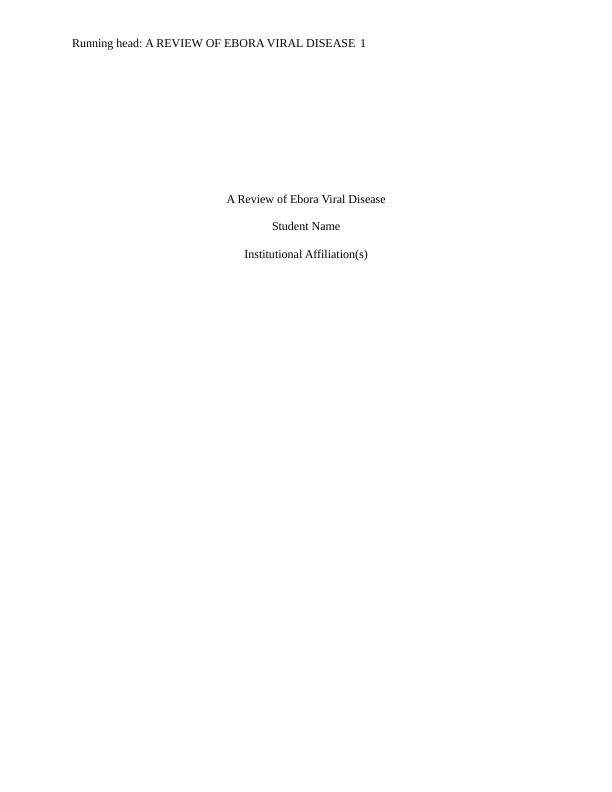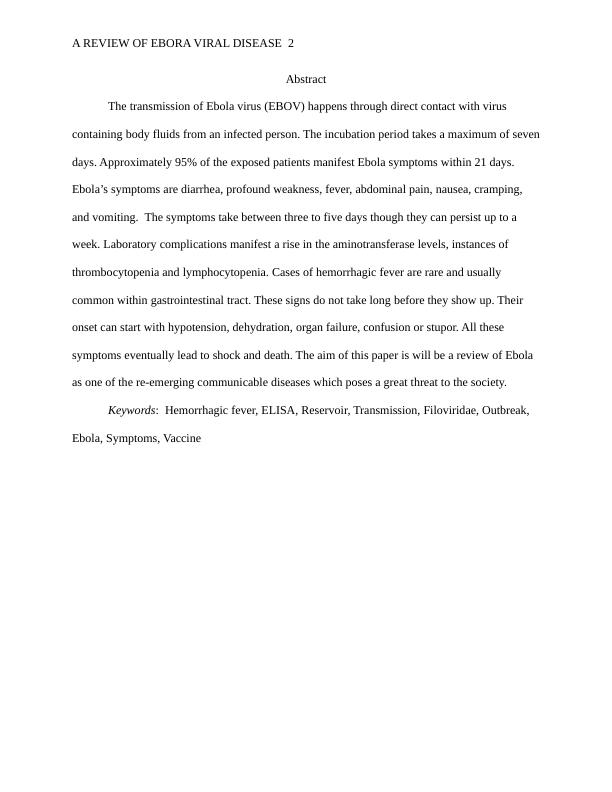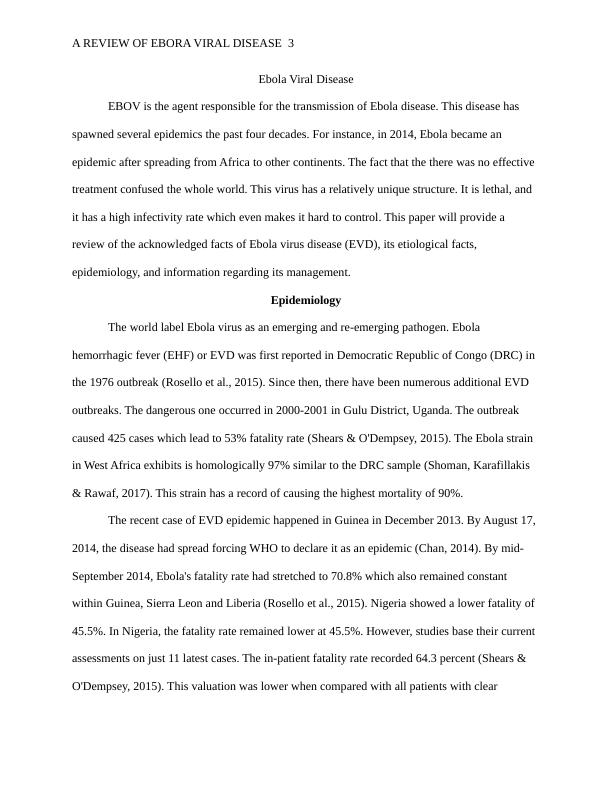A Review of Ebora Viral Disease
17 Pages4908 Words36 Views
Added on 2020-03-16
A Review of Ebora Viral Disease
Added on 2020-03-16
ShareRelated Documents
Running head: A REVIEW OF EBORA VIRAL DISEASE 1
A Review of Ebora Viral Disease
Student Name
Institutional Affiliation(s)
A Review of Ebora Viral Disease
Student Name
Institutional Affiliation(s)

A REVIEW OF EBORA VIRAL DISEASE 2
Abstract
The transmission of Ebola virus (EBOV) happens through direct contact with virus
containing body fluids from an infected person. The incubation period takes a maximum of seven
days. Approximately 95% of the exposed patients manifest Ebola symptoms within 21 days.
Ebola’s symptoms are diarrhea, profound weakness, fever, abdominal pain, nausea, cramping,
and vomiting. The symptoms take between three to five days though they can persist up to a
week. Laboratory complications manifest a rise in the aminotransferase levels, instances of
thrombocytopenia and lymphocytopenia. Cases of hemorrhagic fever are rare and usually
common within gastrointestinal tract. These signs do not take long before they show up. Their
onset can start with hypotension, dehydration, organ failure, confusion or stupor. All these
symptoms eventually lead to shock and death. The aim of this paper is will be a review of Ebola
as one of the re-emerging communicable diseases which poses a great threat to the society.
Keywords: Hemorrhagic fever, ELISA, Reservoir, Transmission, Filoviridae, Outbreak,
Ebola, Symptoms, Vaccine
Abstract
The transmission of Ebola virus (EBOV) happens through direct contact with virus
containing body fluids from an infected person. The incubation period takes a maximum of seven
days. Approximately 95% of the exposed patients manifest Ebola symptoms within 21 days.
Ebola’s symptoms are diarrhea, profound weakness, fever, abdominal pain, nausea, cramping,
and vomiting. The symptoms take between three to five days though they can persist up to a
week. Laboratory complications manifest a rise in the aminotransferase levels, instances of
thrombocytopenia and lymphocytopenia. Cases of hemorrhagic fever are rare and usually
common within gastrointestinal tract. These signs do not take long before they show up. Their
onset can start with hypotension, dehydration, organ failure, confusion or stupor. All these
symptoms eventually lead to shock and death. The aim of this paper is will be a review of Ebola
as one of the re-emerging communicable diseases which poses a great threat to the society.
Keywords: Hemorrhagic fever, ELISA, Reservoir, Transmission, Filoviridae, Outbreak,
Ebola, Symptoms, Vaccine

A REVIEW OF EBORA VIRAL DISEASE 3
Ebola Viral Disease
EBOV is the agent responsible for the transmission of Ebola disease. This disease has
spawned several epidemics the past four decades. For instance, in 2014, Ebola became an
epidemic after spreading from Africa to other continents. The fact that the there was no effective
treatment confused the whole world. This virus has a relatively unique structure. It is lethal, and
it has a high infectivity rate which even makes it hard to control. This paper will provide a
review of the acknowledged facts of Ebola virus disease (EVD), its etiological facts,
epidemiology, and information regarding its management.
Epidemiology
The world label Ebola virus as an emerging and re-emerging pathogen. Ebola
hemorrhagic fever (EHF) or EVD was first reported in Democratic Republic of Congo (DRC) in
the 1976 outbreak (Rosello et al., 2015). Since then, there have been numerous additional EVD
outbreaks. The dangerous one occurred in 2000-2001 in Gulu District, Uganda. The outbreak
caused 425 cases which lead to 53% fatality rate (Shears & O'Dempsey, 2015). The Ebola strain
in West Africa exhibits is homologically 97% similar to the DRC sample (Shoman, Karafillakis
& Rawaf, 2017). This strain has a record of causing the highest mortality of 90%.
The recent case of EVD epidemic happened in Guinea in December 2013. By August 17,
2014, the disease had spread forcing WHO to declare it as an epidemic (Chan, 2014). By mid-
September 2014, Ebola's fatality rate had stretched to 70.8% which also remained constant
within Guinea, Sierra Leon and Liberia (Rosello et al., 2015). Nigeria showed a lower fatality of
45.5%. In Nigeria, the fatality rate remained lower at 45.5%. However, studies base their current
assessments on just 11 latest cases. The in-patient fatality rate recorded 64.3 percent (Shears &
O'Dempsey, 2015). This valuation was lower when compared with all patients with clear
Ebola Viral Disease
EBOV is the agent responsible for the transmission of Ebola disease. This disease has
spawned several epidemics the past four decades. For instance, in 2014, Ebola became an
epidemic after spreading from Africa to other continents. The fact that the there was no effective
treatment confused the whole world. This virus has a relatively unique structure. It is lethal, and
it has a high infectivity rate which even makes it hard to control. This paper will provide a
review of the acknowledged facts of Ebola virus disease (EVD), its etiological facts,
epidemiology, and information regarding its management.
Epidemiology
The world label Ebola virus as an emerging and re-emerging pathogen. Ebola
hemorrhagic fever (EHF) or EVD was first reported in Democratic Republic of Congo (DRC) in
the 1976 outbreak (Rosello et al., 2015). Since then, there have been numerous additional EVD
outbreaks. The dangerous one occurred in 2000-2001 in Gulu District, Uganda. The outbreak
caused 425 cases which lead to 53% fatality rate (Shears & O'Dempsey, 2015). The Ebola strain
in West Africa exhibits is homologically 97% similar to the DRC sample (Shoman, Karafillakis
& Rawaf, 2017). This strain has a record of causing the highest mortality of 90%.
The recent case of EVD epidemic happened in Guinea in December 2013. By August 17,
2014, the disease had spread forcing WHO to declare it as an epidemic (Chan, 2014). By mid-
September 2014, Ebola's fatality rate had stretched to 70.8% which also remained constant
within Guinea, Sierra Leon and Liberia (Rosello et al., 2015). Nigeria showed a lower fatality of
45.5%. In Nigeria, the fatality rate remained lower at 45.5%. However, studies base their current
assessments on just 11 latest cases. The in-patient fatality rate recorded 64.3 percent (Shears &
O'Dempsey, 2015). This valuation was lower when compared with all patients with clear

A REVIEW OF EBORA VIRAL DISEASE 4
outcomes. This rate was also consistent with rates from other countries. A health worker died in
Liberia. Also, the number of new cases increased every week despite having multisectoral and
multinational participation in countering the disease.
At the same time, some of the humanitarian aid practitioners had to go back to their
countries for medical care after contracting Ebola (Kaner & Schaack, 2016). These workers had
contacted the disease despite wearing the personal protection equipment (PPE). One of them led
the case of Ebola in Spain. In October 2014, Liberia citizen traveled to Dallas, Texas. He was
hospitalized and died of Ebola. This patient led to the infection of other individuals some of them
being two healthcare workers who also had their PPE (Mbonye et al., 2014). The WHO Ebola
Response Team predicted an increase of deaths by November 2014 urging the global community
to respond to more efficient methods of managing the diseases (Mbonye et al., 2014).
Agents of EVD
EBOV belong to the species Zaire ebolavirus, the genus Ebolavirus, and the family
Filoviridae (Weston, Burgess & Roberts, 2016). The genus Ebolavirus has five different viruses.
These include the Sudan virus (SUDV), Bundibugyo virus, EBOV, Reston virus, and Tai Forest
virus (Lukashevich & Shirwan, 2014). Among these, EBOV causes EHF and it has the highest
fatality rate between 57 and 90 percent in humans (Weston, Burgess & Roberts, 2016). SUDV
follows with a rate between 41 and 65 percent. Bundibugyo virus has a fatality rate of percent
(Weston, Burgess & Roberts, 2016). The work of (Sanford, West & Jacob, 2017) states that Tai
Forest virus has only caused two human infections which are nonfatal. Reston virus is the
causing agent for asymptomatic condition in humans.
outcomes. This rate was also consistent with rates from other countries. A health worker died in
Liberia. Also, the number of new cases increased every week despite having multisectoral and
multinational participation in countering the disease.
At the same time, some of the humanitarian aid practitioners had to go back to their
countries for medical care after contracting Ebola (Kaner & Schaack, 2016). These workers had
contacted the disease despite wearing the personal protection equipment (PPE). One of them led
the case of Ebola in Spain. In October 2014, Liberia citizen traveled to Dallas, Texas. He was
hospitalized and died of Ebola. This patient led to the infection of other individuals some of them
being two healthcare workers who also had their PPE (Mbonye et al., 2014). The WHO Ebola
Response Team predicted an increase of deaths by November 2014 urging the global community
to respond to more efficient methods of managing the diseases (Mbonye et al., 2014).
Agents of EVD
EBOV belong to the species Zaire ebolavirus, the genus Ebolavirus, and the family
Filoviridae (Weston, Burgess & Roberts, 2016). The genus Ebolavirus has five different viruses.
These include the Sudan virus (SUDV), Bundibugyo virus, EBOV, Reston virus, and Tai Forest
virus (Lukashevich & Shirwan, 2014). Among these, EBOV causes EHF and it has the highest
fatality rate between 57 and 90 percent in humans (Weston, Burgess & Roberts, 2016). SUDV
follows with a rate between 41 and 65 percent. Bundibugyo virus has a fatality rate of percent
(Weston, Burgess & Roberts, 2016). The work of (Sanford, West & Jacob, 2017) states that Tai
Forest virus has only caused two human infections which are nonfatal. Reston virus is the
causing agent for asymptomatic condition in humans.

End of preview
Want to access all the pages? Upload your documents or become a member.
Related Documents
Ebola Virus: Transmission, Symptoms, Diagnosis, Treatment and Preventionlg...
|14
|4417
|111
Essay on Ebola Outbreak Preventionlg...
|14
|4066
|199
Essay | Global Travel With Respect to Ebolalg...
|13
|3674
|36
Ebola Virus Disease: Causes, Symptoms, and Environmental Factorslg...
|14
|4463
|473
Ebola Crisis and Intervention Strategylg...
|11
|2025
|147
Globalization and Public Health Management of Ebolalg...
|7
|2559
|344
